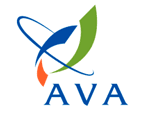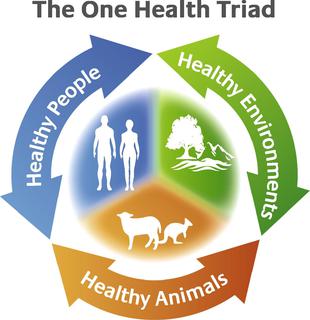
A zoonosis or zoonotic disease is an infectious disease of humans caused by a pathogen that can jump from a non-human to a human and vice versa.

Fish farming or pisciculture involves commercial breeding of fish, most often for food, in fish tanks or artificial enclosures such as fish ponds. It is a particular type of aquaculture, which is the controlled cultivation and harvesting of aquatic animals such as fish, crustaceans, molluscs and so on, in natural or pseudo-natural environments. A facility that releases juvenile fish into the wild for recreational fishing or to supplement a species' natural numbers is generally referred to as a fish hatchery. Worldwide, the most important fish species produced in fish farming are carp, catfish, salmon and tilapia.

Animal husbandry is the branch of agriculture concerned with animals that are raised for meat, fibre, milk, or other products. It includes day-to-day care, management, production, nutrition, selective breeding, and the raising of livestock. Husbandry has a long history, starting with the Neolithic Revolution when animals were first domesticated, from around 13,000 BC onwards, predating farming of the first crops. By the time of early civilisations such as ancient Egypt, cattle, sheep, goats, and pigs were being raised on farms.

A veterinarian (vet) is a medical professional who practices veterinary medicine. They manage a wide range of health conditions and injuries in non-human animals. Along with this, veterinarians also play a role in animal reproduction, health management, conservation, husbandry and breeding and preventive medicine like nutrition, vaccination and parasitic control as well as biosecurity and zoonotic disease surveillance and prevention.
The Veterinary Medicines Directorate (VMD) is an Executive Agency of the Department for Environment, Food and Rural Affairs (Defra) seeking to protect public health, animal health, the environment and promoting animal welfare by assuring the safety, quality and efficacy of veterinary medicines in the United Kingdom.
Med-Vet-Net is a European Network of Excellence for zoonosis research. The Network officially commenced on 1 September 2004 until 31 October 2009. It was funded for five years at a cost of €14.4 million by the European Union (EU) 6th Framework Programme, within the ‘Quality and Safety of Food’ Priority Area. In October 2009 the network continued to start the Med-Vet-Net Association for Zoonoses Research.

Intensive animal farming, industrial livestock production, and macro-farms, also known as factory farming, is a type of intensive agriculture, specifically an approach to animal husbandry designed to maximize production while minimizing costs. To achieve this, agribusinesses keep livestock such as cattle, poultry, and fish at high stocking densities, at large scale, and using modern machinery, biotechnology, and global trade. The main products of this industry are meat, milk and eggs for human consumption. There are issues regarding whether intensive animal farming is sustainable in the social long-run given its costs in resources. Analysts also raise issues about its ethics.
Manitoba Agriculture—officially the Department of Agriculture and Resource Development —is the department of the Government of Manitoba responsible for the agriculture and natural resources sectors in Manitoba, including agrifood, agriproduct, and food safety, as well as animal health and welfare.

The Agri-Food and Veterinary Authority of Singapore (AVA) was a statutory board under the Ministry of National Development that regulated food safety, safeguarded animal and plant health, and facilitated the agri-food and fisheries trade sectors. AVA was disbanded on 1 April 2019, with duties being transferred to other statutory boards, Singapore Food Agency, National Environment Agency, Health Sciences Authority, and National Parks Board.

One Health is an approach calling for "the collaborative efforts of multiple disciplines working locally, nationally, and globally, to attain optimal health for people, animals and our environment", as defined by the One Health Initiative Task Force (OHITF). It developed in response to evidence of the spreading of zoonotic diseases between species and increasing awareness of "the interdependence of human and animal health and ecological change". In this viewpoint, public health is no longer seen in purely human terms. Due to a shared environment and highly conserved physiology, animals and humans not only suffer from the same zoonotic diseases, but can also be treated by either structurally related or identical drugs. For this reason, special care must be taken to avoid unnecessary or over-treatment of zoonotic diseases, particularly in the context of drug resistance in infectious microbes.

Antibiotics are commonly used in commercial swine production in the United States and around the world. They are used for disease treatment, disease prevention and control, and growth promotion. When used for growth promoting purposes, antibiotics are given at low concentrations for long periods of time. Low concentration of antibiotics, also referred to as subtherapeutic (STA), are given as feed and water additives which improve daily weight gain and feed efficiency through alterations in digestion and disease suppression. Additionally, the use of STA in swine results in healthier animals and reduces the “microbial load” on meat resulting in an assumed decrease in potential Foodborne illness risk. While the benefits of subtherapeutic antibiotic administration are well-documented, there is much concern and debate regarding the development of bacterial antibiotic resistance associated with their use.
The Moredun Research Institute is a scientific research institution based at the Pentlands Science Park, in the Bush Estate area of Midlothian, Scotland. It conducts research into diseases of farm livestock and the promotion of animal health and welfare.

Antibiotic use in livestock is the use of antibiotics for any purpose in the husbandry of livestock, which includes treatment when ill (therapeutic), treatment of a group of animals when at least one is diagnosed with clinical infection (metaphylaxis), and preventative treatment (prophylaxis). Antibiotics are an important tool to treat animal as well as human disease, safeguard animal health and welfare, and support food safety. However, used irresponsibly, this may lead to antibiotic resistance which may impact human, animal and environmental health.

The concept of One Health is the unity of multiple practices that work together locally, nationally, and globally to help achieve optimal health for people, animals, and the environment. When the people, animals, and environment are put together they make up the One Health Triad .The One Health Triad shows how the health of people, animals, and the environment is linked to one another. With One Health being a worldwide concept, it makes it easier to advance health care in the 21st century. When this concept is used, and implied properly it can help protect and save the lives of both people, animals, and the environment in the present and future generations.
The Canadian Veterinary Medical Association, founded in 1876, provides leadership on national veterinary issues, advocates for animal welfare, and works to encourage life balance in veterinary professionals.
Food Animal Concerns Trust (FACT) is a nonprofit organization in the U.S. concerned with food safety and animal welfare. FACT was founded in 1982 as the first U.S. organization devoted exclusively to addressing the public health problems that result from raising farm animals in confined and inhumane conditions.
Antibiotic use in the United States poultry farming industry is the controversial prophylactic use of antibiotics in the country's poultry farming industry. It differs from the common practice in Europe, where antibiotics for growth promotion were disallowed in the 1950s.
Laura H. Kahn is a native Californian. She is an author, lecturer, a general internist physician, and a research scholar with the Program on Science and Global Security at the Woodrow Wilson School of Public and International Affairs at Princeton University in New Jersey. She is the co-founder, of One Health Initiative. She is an online columnist for the Bulletin of the Atomic Scientists. She is an expert advisor and author in the field of zoonosis. Zoonosis is the study of infectious diseases where cross-species illnesses that are caused by bacteria, viruses, or parasites spread from non-human animals to humans. She is the author of Who's in Charge? Leadership During Epidemics, Bioterror Attacks, and Other Public Health Crises
Salma Sultana is a veterinarian, entrepreneur, and researcher. She is the recipient of the 2020 The Norman E. Borlaug Award for field research and application. She has also been honored by World Food Prize Foundation. Sultana has received this award for her innovative model of providing veterinary outreach, treatment, and education to thousands of small-scale farmers in Bangladesh.
An occupational infectious disease is an infectious disease that is contracted at the workplace. Biological hazards (biohazards) include infectious microorganisms such as viruses, bacteria and toxins produced by those organisms such as anthrax.









